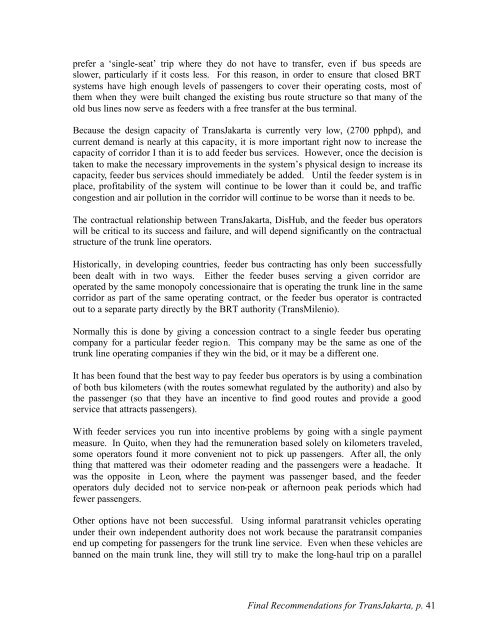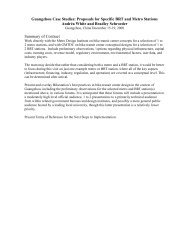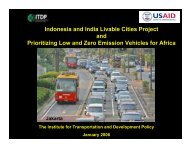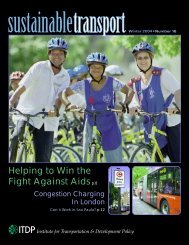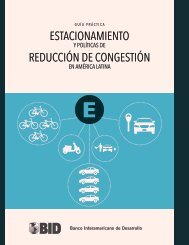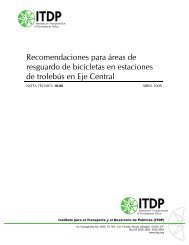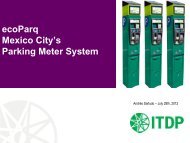Making TransJakarta a World Class BRT System - ITDP | Institute for ...
Making TransJakarta a World Class BRT System - ITDP | Institute for ...
Making TransJakarta a World Class BRT System - ITDP | Institute for ...
Create successful ePaper yourself
Turn your PDF publications into a flip-book with our unique Google optimized e-Paper software.
prefer a ‘single-seat’ trip where they do not have to transfer, even if bus speeds are<br />
slower, particularly if it costs less. For this reason, in order to ensure that closed <strong>BRT</strong><br />
systems have high enough levels of passengers to cover their operating costs, most of<br />
them when they were built changed the existing bus route structure so that many of the<br />
old bus lines now serve as feeders with a free transfer at the bus terminal.<br />
Because the design capacity of <strong>TransJakarta</strong> is currently very low, (2700 pphpd), and<br />
current demand is nearly at this capacity, it is more important right now to increase the<br />
capacity of corridor I than it is to add feeder bus services. However, once the decision is<br />
taken to make the necessary improvements in the system’s physical design to increase its<br />
capacity, feeder bus services should immediately be added. Until the feeder system is in<br />
place, profitability of the system will continue to be lower than it could be, and traffic<br />
congestion and air pollution in the corridor will continue to be worse than it needs to be.<br />
The contractual relationship between <strong>TransJakarta</strong>, DisHub, and the feeder bus operators<br />
will be critical to its success and failure, and will depend significantly on the contractual<br />
structure of the trunk line operators.<br />
Historically, in developing countries, feeder bus contracting has only been successfully<br />
been dealt with in two ways. Either the feeder buses serving a given corridor are<br />
operated by the same monopoly concessionaire that is operating the trunk line in the same<br />
corridor as part of the same operating contract, or the feeder bus operator is contracted<br />
out to a separate party directly by the <strong>BRT</strong> authority (TransMilenio).<br />
Normally this is done by giving a concession contract to a single feeder bus operating<br />
company <strong>for</strong> a particular feeder region. This company may be the same as one of the<br />
trunk line operating companies if they win the bid, or it may be a different one.<br />
It has been found that the best way to pay feeder bus operators is by using a combination<br />
of both bus kilometers (with the routes somewhat regulated by the authority) and also by<br />
the passenger (so that they have an incentive to find good routes and provide a good<br />
service that attracts passengers).<br />
With feeder services you run into incentive problems by going with a single payment<br />
measure. In Quito, when they had the remuneration based solely on kilometers traveled,<br />
some operators found it more convenient not to pick up passengers. After all, the only<br />
thing that mattered was their odometer reading and the passengers were a headache. It<br />
was the opposite in Leon, where the payment was passenger based, and the feeder<br />
operators duly decided not to service non-peak or afternoon peak periods which had<br />
fewer passengers.<br />
Other options have not been successful. Using in<strong>for</strong>mal paratransit vehicles operating<br />
under their own independent authority does not work because the paratransit companies<br />
end up competing <strong>for</strong> passengers <strong>for</strong> the trunk line service. Even when these vehicles are<br />
banned on the main trunk line, they will still try to make the long-haul trip on a parallel<br />
Final Recommendations <strong>for</strong> <strong>TransJakarta</strong>, p. 41


